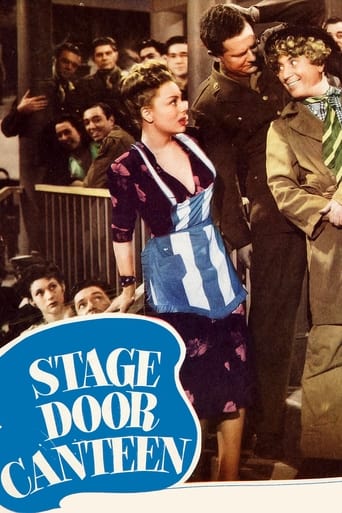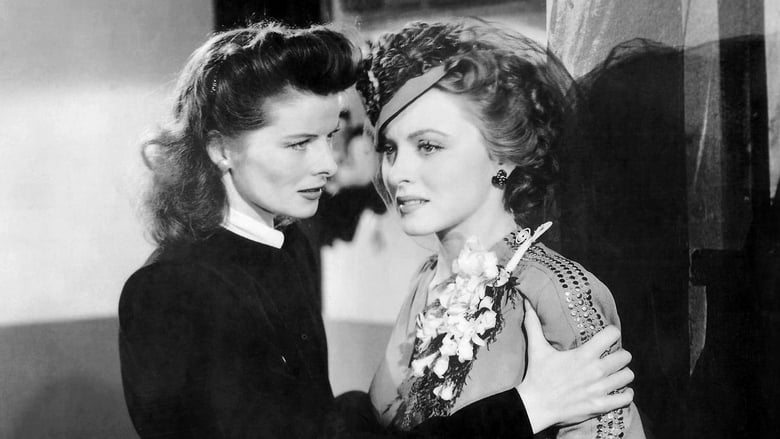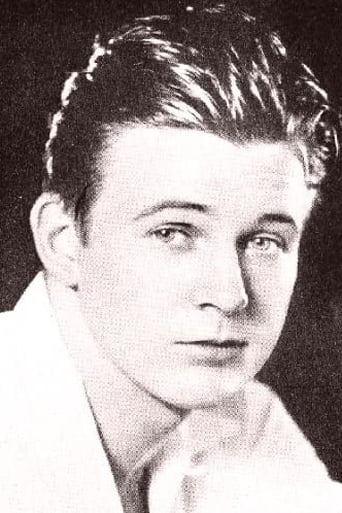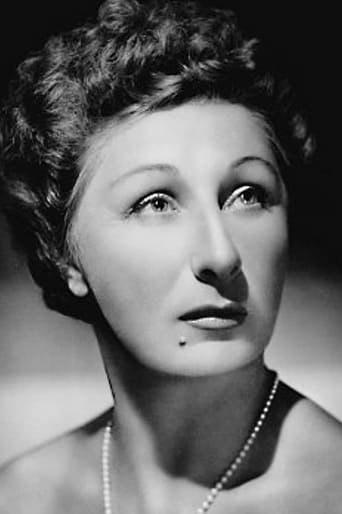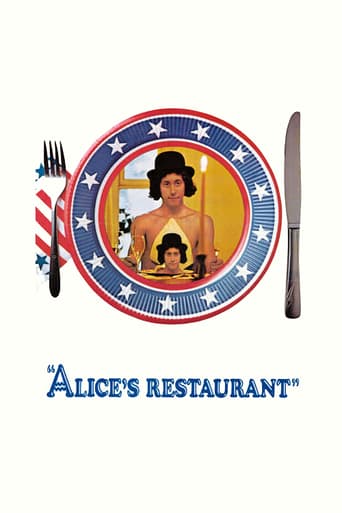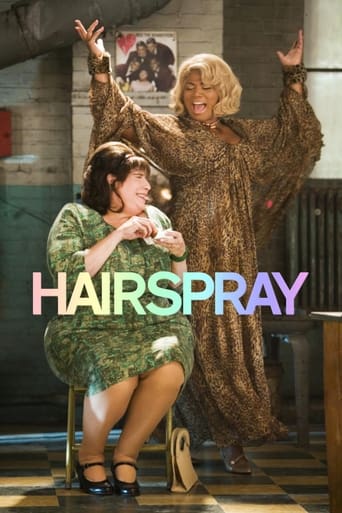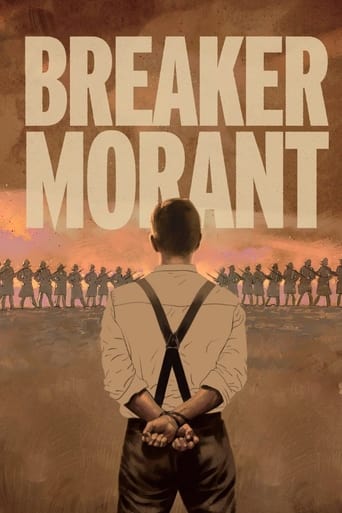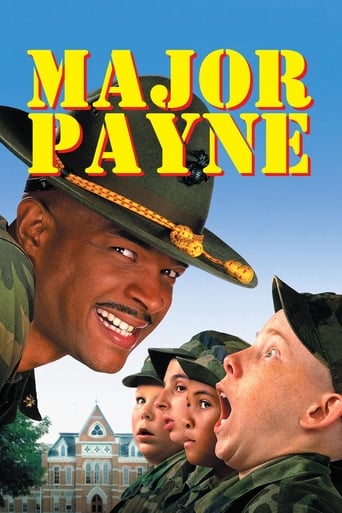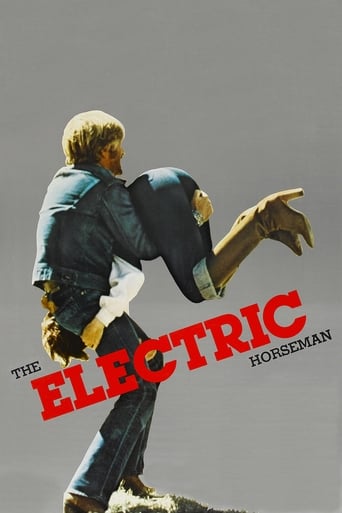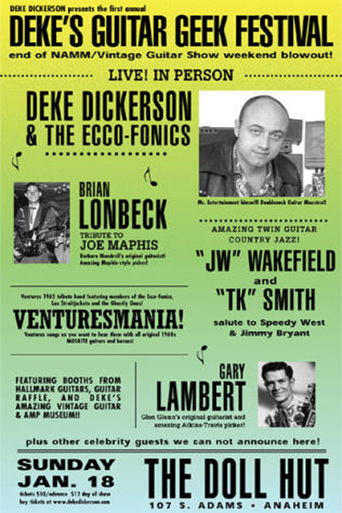Stage Door Canteen (1943)
A young soldier on a pass in New York City visits the famed Stage Door Canteen, where famous stars of the theater and films appear and host a recreational center for servicemen during the war. The soldier meets a pretty young hostess and they enjoy the many entertainers and a growing romance
Watch Trailer
Free Trial Channels
Cast


Similar titles
Reviews
Most undeservingly overhyped movie of all time??
It's fun, it's light, [but] it has a hard time when its tries to get heavy.
Easily the biggest piece of Right wing non sense propaganda I ever saw.
It really made me laugh, but for some moments I was tearing up because I could relate so much.
STAGE DOOR CANTEEN (United Artists, 1943), produced and directed by Frank Borzage, is not a sequel to the 1937 classic, STAGE DOOR, starring Katharine Hepburn. Though Hepburn does appear in this wartime musical with a huge all star cast, her role very much is brief, nearly coming towards the bitter end where she does her brief dramatic turn opposite the lead actress, Cheryl Walker. Following the tradition of other studios featuring all-star casts that started with STAR SPANGLED RHYTHM (Paramount, 1942), followed by a similar structure with HOLLYWOOD CANTEEN (Warner Brothers, 1944), United Artists contributed its services with STAGE DOOR CANTEEN with a handful of popular star performers of the day, ranging from motion pictures, theater or radio, entertainers doing either brief cameos or participation in a song or two, as part of the entertainment effort for the soldiers on leave during World War II. The thin plot opens with Army soldiers on a train heading for an unknown destination. The soldiers in question are Ed "Dakota" Smith (William Terry), Jack "California" Gilman (Lon McCallister) who has never kissed a girl; "Texas" (Michael Harrison), "Jersey" Wallace (Fred Brady) and The Australian (Patrick O'Moore). Entering New York City for some recreation, the soldiers enter the Stage Door Canteen where they encounter many entertainers and working girls, one named Eileen (Cheryl Walker), who, at the risk of her losing her job, becomes a romantic interest with one the soldiers. Also in the story cast are Marjorie Riordan (Jean); Dorothea Kent (Mamie); Marion Shockley (Lillian) and Margaret Early (Ella Sue). With plenty songs taking up much of the proceedings, the motion picture soundtrack and participants are as follows: "The Machine Gun Song" and "Our Father Prayer (both sung by Gracie Fields); "A Rookie and his Rhythm" and "Sleep Baby Sleep" (Kay Kyser Band); "The Girl I Love to Leave Behind" (Ray Bolger song and tap dance); "Goodnight, Sweetheart" (instrumental); "Sing Hallelujah" (Ethel Merman); "Bombshell from Brooklyn" (Xavier Cugat and Orchestra/Lina Romay); "U.S. Marine Song," "Sleep Baby Sleep" (Guy Lombardo and his Orchestra); "Goodnight, Sweetheart" (Kenny Baker); "Quicksand" (Ethel Waters); Gypsy Rose Lee specialty; "Don't Worry Island" (Freddie Martin and his Orchestra); "The Chinese Fighting March," "Old Acquaintance" (Guy Lombardo and his Orchestra); "We Mustn't Say Goodbye" (Kenny Baker); "Get Outta Here and Give Me Some Money" (Benny Goodman Orchestra/sung by Peggy Lee); "Heartful of Music" (instrumental, Benny Goodman Orchestra); Franz Shubert's "Ave Maria" (violin playing by Yehudi Menuhin); "The Flight of the Bumble Bee" and "Goodnight, Sweetheart." Of the handful of tunes, "We Mustn't Say Goodbye" got an Academy Award nomination as Best Song of 1943, though "Sing Hallelujah" and "Sleep, Baby, Sleep" are much more memorable. Notable scenes include Katherine Cornell reciting her scene from "Romeo and Juliet," Alfred Lunt and Lynn Fontanne in rare screen appearance; George Jessel talking to his family in telephone booth between musical segments; and Hollywood in-joke on the movie's Tarzan, Johnny Weissmuller, being more natural by taking off his shirt while washing dishes in the kitchen with Franklin Pangborn; and of course Harpo Marx, of Marx Brothers fame, silently honking and chasing a girl. With the guest stars too numerous to mention, with Bert Lytell and Allen Jenkins acting as individual masters of ceremonies, other star performers inlude Tallulah Bankhead, George Raft, Helen Hayes, Merle Oberon, Aline MacMahon, Paul Muni, Ned Sparks and many others. Since Frank Borzage is known for his sentimental touches, STAGE DOOR CANTEEN takes time away from song interludes for some serious moments involving the girl loving soldier theme; Sam Jaffe talking with refugees, and Katharine Hepburn being serious while consulting with Eileen's (Cheryl Walker) problem. In spite of its great length (132 minutes) and the sort of wartime musical that cries for Technicolor, STAGE DOOR CANTEEN, especially with its star cast, simply reflects the times when ll Americans stood together as one during the war years. As being the sort of movie for the time capsule, it's no doubt highly entertaining, especially when movie star searching is concerned. Being a public domain title, it's become available on video cassette and public television dating back to the 1980s, followed by years later on DVD. It also has had its broadcasts on cable television, notably on American Movie Classics (1989-1990) and Turner Classic Movies. (***1/2)
It's a shame that many of the great stars here do not appear together, for it is a movie and theater addict's dream to see such fabulous personalities like Tallulah Bankhead, Judith Anderson, Katharine Hepburn, Katherine Cornell and Lynn Fontanne work together, in addition to socializing. Some are on and off so fast that you may forget that they were in this classic World War II musical overstuffed with talent. It's no different than the more well known "Hollywood Canteen" made by Warner Brothers the following year, featuring some dramatic stars doing musical numbers and tons and tons of specialties.The dramatic stars here don't sing or dance; They mainly walk around and socialize with the soldiers and sailors patronizing the famous nightclub where only military personnel were allowed to visit. Some film personalities not known for their stage work do appear here, most memorably Johnny Weismueller (showing the very macho Franklin Pangborn how to do his Tarzan yell), Merle Oberon, William Demarest, recording star Peggy Lee, and radio personalities Kay Kyser, Edgar Bergen and Jack Benny.Among the recent Broadway stars who get to perform musical numbers are Broadway's two Ethels (Waters and Merman) and Ray Bolger, with comic moments from Ed Wynn and Hugh Herbert and a particularly memorable anti-Nazi song (followed with a musical rendering of "The Lord's Prayer") by British comic favorite Gracie Fields. The rare film appearance by the legendary Katherine Cornell is memorable by her sudden recital of a scene from "Romeo and Juliet" with a stage struck soldier. Bankhead roams around the tables as only she can, offering unsolicited advice to the romantic goings on between the soldiers and the girls working at the factory. What little story there is involves canteen worker Cheryl Walker who marries a visiting soldier and is dismissed from her duties by president Selena Royle for breaking the rules. Walker is consoled by Katherine Hepburn who provides the moral of the story. Those watching this lengthy film simply for her presence in it will have to wait more than two hours for her appearance, but she makes the most out of her small cameo.The magnificent Judith Anderson gets to show her real personality by being rather flip with a soldier who didn't recognize her when she greeted him upon his arrival. The film makes more attention towards her role of Mrs. Danvers in "Rebecca" than it does her legendary stage work which was very active at this time with acclaimed revivals of "Hamlet" and "The Three Sisters" while making occasional supporting appearances in movies. Dame May Witty, very busy in movies at this time, is a surprise visitor to the canteen, treated very regally in her encounter with the beautiful Merle Oberon. The film does make its point with all of these cameos, being a very important historical record of how soldiers and sailors on leave were entertained while on the town.
This is my fourth review of a "war musical"-having previously commented on Something for the Boys, Thank Your Lucky Stars, and This is the Army-that was made during and alluded to World War II. In this one, four G.I.'s are given a pass to New York and go the the title place where they have free refreshments and dances. Three of them meet the women who work there and they all seem to fall in love. That's all I'll mention of the plot which is more serious than the previous ones of the movies I just mentioned and as such there is more gravity concerning the dialogue when they discuss fates of what might happen. But that doesn't take away from the entertainment of seeing so many cameos of the various stars that appear here with plenty of good comedy and music that gives one pause constantly. I won't mention who they are (you probably know already if you've looked at the cast list or the other reviews near mine) but if you love this particular era of movies, you won't be disappointed when you see them. So on that note, I highly recommend Stage Door Canteen.
As a film, this is almost tissue-paper thin. The leading characters are almost stereotypes, the plot is tediously predictable, and the work's values are conventionally true-blue.And yet: this, I think, is a valuable film for what it captures about the mood and values of the nation in 1943. Katherine Hepburn's speech near the end to the young lass whose fiancé missed their wedding due to deployment orders, I think, grasps the essence of what the U.S. was dealing with in the troubling year of 1943 (remember, the air campaign over Europe had been dealt setback after setback, in the Pacific U.S. forces were still slogging up the Solomons and New Guinea, and the 1st ID had just been handed its helmet at Kasserine Pass).There's an air of both uncertainty and hope in this film -- the sense that a lot of these lads were going over and never coming back, combined with a sense of resolve: it was a dark hour, but we're going to prevail. And we're going to do what we can for the troops as they embark and return.So I have a world of respect for the performers who make cameos in this film: Goodman, Basie, Kyser, Bellamy, Bergen, Hepburn -- the list is immense. They probably got paid for it, but they still invested their clout, their personality, their franchise, for an unabashed paean to U.S. soldiers. I know it was a simpler times and the issues were more clear, but I doubt you'd see a comparable lineup today honoring U.S. troops in Afghanistan, etc.

